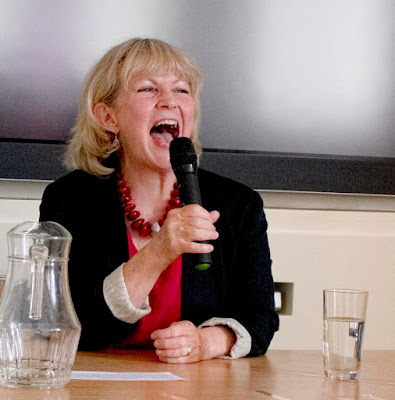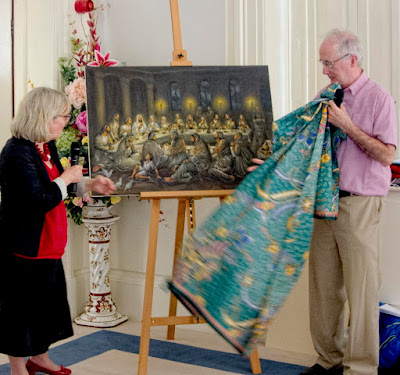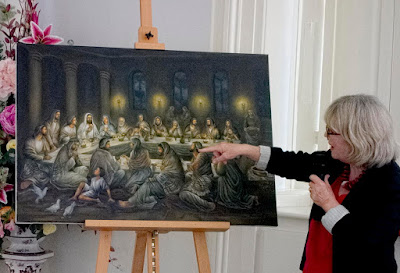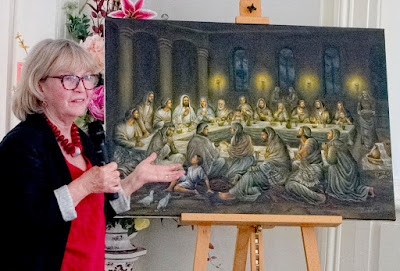I had seen Tina Beattie once on telly chairing a discussion and she impressed.
So, when We Are Church Ireland, for which I have a certain affection, decided to invite her over from the UK to give one of their talks, I figured I was not going to miss it.
Got my ticket in good time and was looking forward to it when it suddenly transpired that I'd have to forgo a cremation (not my own, yet) to attend. So I thought this had better be good.
I got to wonder beforehand if Tina would have ever heard of my hero Anne Bieźanek. That was a long time ago and my impression was that she had been forgotten by all bar her family and myself.
When I asked Tina I was amazed at her reply. Someone had just written an article about Anne in a Catholic Women Speak magazine and she is to send me a copy. So, that was off to a good start.
Tina's talk, as you can see from the image at the head of this post, was about women in the Roman Catholic (Apostolic and Universal) Church. She has intriguingly distinguished in the title between Hope and Optimism.
And she went on at the beginning to present us with three further distinguishing headlines: Memory versus Nostalgia; Imagination versus Fantasy; Reality versus Unreality.
You may wonder at these distinctions, but when you've heard the talk you'll know it's about walking the walk. In each case the first term is pressed into active service and the second is a passive alternative.
Hope versus Optimism: where Optimism is taken as just hanging around and expecting the future to be better without having to do anything about it. This is the drug that the church hierarchy are peddling to us and to women in particular. Hope, on the other hand is taking action and hoping to change things.
Memory versus Nostalgia: where Nostalgia is a hankering after the past (which may never even have existed). This is what the Church is doing with its millennium tradition of excluding women from ministry. An immutable past whether real or not. Memory involves re-examining and questioning the past and using this to support change for the better.
Imagination versus Fantasy: where Fantasy is deluding oneself that thing are better now, or at least they look better in the mind. I won't comment on this one as it might get me into trouble. Imagination is having the courage to imagine things differently and do something to help bring it about.
Reality versus Unreality: I think that one speaks unambiguously for itself.
Now I'm not saying the above words were Tina's own. They're mine. But they are what I took away from the talk as interpretations of these provocative headlines.
If there is a single word to describe the essence of the talk it's activism.
Referring to the Synod of Bishops on Youth held in Rome in October 2018, Tina pointed out that though women religious (nuns) got to attend this synod they did not have any votes unlike their male religious counterparts.
Women protested peacefully outside at various defects in the Synod from their point of view and police attempted to "robustly" move them on.
We were treated to a video of this police exercise and who did we spot in the middle of it all, loudly protesting and waving her hands in admonition, but our Ursula. A Roman film star no less.
Tina told us how she had once complained, I think it was to a member of the hierarchy, at the constant use of the term "man" in describing human affairs. She was given the old line of "when I say man I embrace woman" smart rubbish. Well then she says what about when you ordain men, is that not supposed to include us? Oh, but you're a woman, was the reply.
I don't think she threw a brick at him, she's not that way inclined. However, had she done so I'm sure no jury of twelve women would have convicted.
Tina also challenged the traditional definition of the Magisterium the teaching core and repository of the church's wisdom. Some definitions would have confined this to the Pope and the CDF. But no matter how much it was broadened it never went beyond the hierarchy and maybe a few high power kosher theologians.
But enter the sensus fidei and it's a different story entirely. Then nothing becomes official teaching unless it gains wide acceptance among the faithful. As Tina pointed out, on that basis Humanae Vitae, ignored/rejected by 90% of Catholics, is not part of church teaching, much less infallibly so. Tony Flannery has also frequently made this point regarding the Magisterium.
Tina told us about the forum she had set up called Catholic Women Speak which allows women to work together to create the space for dialogue, theological exploration and collaboration among Catholic women in the worldwide Church.
You can check out the public site for stories and interviews. Many of the points Tina made in the course of her talk can be found here (and a lot more besides).
Now, I'm not an ankle man myself but I'm sure in the age of Joyce this sight would have turned many a male head.
However it was Tina heself who directed our gaze at her red slippers. I didn't catch the full story but I think they may be the equivalent of the Freemasons' handshake among a group of progressive women.
On to the Q&A. I'm not going to say much about this beyond it was very positive in the sense of supporting Tina's point of view. My attitude at Q&As is the following. If nobody pipes up I'll ask a question, no matter how trivial, to get the ball rolling. If people do speak up I wait and if their questions seem more important than mine I let them at it.
Well this was a session of heavies which included a female theologian, a veteran feminist and an Anglican man from Newry. So I kept my mouth firmly shut and saved my question for another time when it might be more needed.
You'll gather from the sequence of shots below that it was an animated session.
And finally the formal unveiling of the real last supper and not the one colluded with by Leonardo da Vinci, designed to copperfasten the male priesthood in perpetuity. There are women and children in this one as Tina was quick to point out.
About Nora Kelly's LAST SUPPER
This painting of the Last Supper includes 6 women and 3 children, as well as Christ and His 12 apostles. Most classic paintings of the Last Supper (like Leonardo DaVinci’s Masterpiece) only show Christ and His 12 male apostles. But we know from scripture that Christ’s women disciples and His mother Mary had followed Him from Galilee up to Jerusalem, and the next day it was the women who were at the foot of the cross when the men ran away. This painting also shows a traditional Jewish Passover meal, with all the men wearing prayer shawls, eating with their right hands and reclining around a low table on cushions and rugs. On the right side of the painting can be seen the basin and a towel from the washing of the feet.
And finally, her own copy of the picture as a parting gift from WAC.
And a proper look.
Q&A on Youtube
Unveiling the Last Supper
























No comments:
Post a Comment